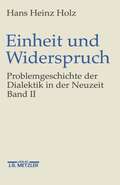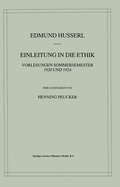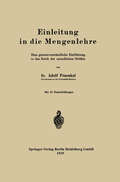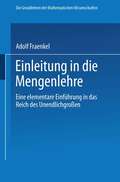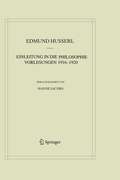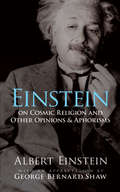- Table View
- List View
Einheit und Widerspruch: Problemgeschichte der Dialektik in der Neuzeit.Band 1: Die Signatur der Neuzeit
by Hans Heinz HolzVermittlung der Widersprüche - die dialektische Bewegung des Philosophierens. Die Konstruktion der Einheit von Widersprüchlichem in einem Weltmodell ist seit Platon ein zentrales Anliegen der Philosophie. In der Neuzeit ist es das Verhältnis von Begriff und Wirklichkeit, in dem sich die Reflexion dieses Problems entfaltet. Die Geschichte der dialektischen Denkbewegung in der Neuzeit ist Thema der dreibändigen Darstellung.
Einheit und Widerspruch: Problemgeschichte der Dialektik in der Neuzeit.Band 2: Pluralität und Einheit
by Hans Heinz HolzVermittlung der Widersprüche - die dialektische Bewegung des Philosophierens. Die Konstruktion der Einheit von Widersprüchlichem in einem Weltmodell ist seit Platon ein zentrales Anliegen der Philosophie. In der Neuzeit ist es das Verhältnis von Begriff und Wirklichkeit, in dem sich die Reflexion dieses Problems entfaltet. Die Geschichte der dialektischen Denkbewegung in der Neuzeit ist Thema der dreibändigen Darstellung. In Band 2 setzt ein bei der kritischen Aufhebung der Metaphysik durch Kant und endet bei ihrer Restitution im deutschen Idealismus gipfelend in Hegel.
Einheit und Widerspruch: Problemgeschichte der Dialektik in der Neuzeit.Band 3: Die Ausarbeitung der Dialektik
by Hans Heinz HolzVermittlung der Widersprüche - die dialektische Bewegung des Philosophierens. Die Konstruktion der Einheit von Widersprüchlichem in einem Weltmodell ist seit Platon ein zentrales Anliegen der Philosophie. In der Neuzeit ist es das Verhältnis von Begriff und Wirklichkeit, in dem sich die Reflexion dieses Problems entfaltet. Die Geschichte der dialektischen Denkbewegung in der Neuzeit ist Thema der dreibändigen Darstellung.
Einleitung in die Ethik: Vorlesungen Sommersemester 1920/1924 (Husserliana: Edmund Husserl – Gesammelte Werke #37)
by Edmund Husserl Henning Peucker
Einleitung in die Logik und Erkenntnistheorie Vorlesungen 1906/07: Vorlesungen 1906/07 (Husserliana: Edmund Husserl – Gesammelte Werke #24)
by Edmund Husserl Ullrich MelleEinleitung in die Mengenlehre: Eine gemeinverständliche Einführung in das Reich der unendlichen Größen
by Abraham Adolf FraenkelDieser Buchtitel ist Teil des Digitalisierungsprojekts Springer Book Archives mit Publikationen, die seit den Anfängen des Verlags von 1842 erschienen sind. Der Verlag stellt mit diesem Archiv Quellen für die historische wie auch die disziplingeschichtliche Forschung zur Verfügung, die jeweils im historischen Kontext betrachtet werden müssen. Dieser Titel erschien in der Zeit vor 1945 und wird daher in seiner zeittypischen politisch-ideologischen Ausrichtung vom Verlag nicht beworben.
Einleitung in die Mengenlehre (Grundlehren der mathematischen Wissenschaften #9 )
by Abraham Adolf FraenkelDieser Buchtitel ist Teil des Digitalisierungsprojekts Springer Book Archives mit Publikationen, die seit den Anfängen des Verlags von 1842 erschienen sind. Der Verlag stellt mit diesem Archiv Quellen für die historische wie auch die disziplingeschichtliche Forschung zur Verfügung, die jeweils im historischen Kontext betrachtet werden müssen. Dieser Titel erschien in der Zeit vor 1945 und wird daher in seiner zeittypischen politisch-ideologischen Ausrichtung vom Verlag nicht beworben.
Einleitung in die Mengenlehre: Eine Elementare Einführung in das Reich des Unendlichgrossen (Grundlehren der mathematischen Wissenschaften #9)
by Adolf FraenkelDieser Buchtitel ist Teil des Digitalisierungsprojekts Springer Book Archives mit Publikationen, die seit den Anfängen des Verlags von 1842 erschienen sind. Der Verlag stellt mit diesem Archiv Quellen für die historische wie auch die disziplingeschichtliche Forschung zur Verfügung, die jeweils im historischen Kontext betrachtet werden müssen. Dieser Titel erschien in der Zeit vor 1945 und wird daher in seiner zeittypischen politisch-ideologischen Ausrichtung vom Verlag nicht beworben.
Einleitung in die Phänomenologie: Vorlesung 1912 (Husserliana: Edmund Husserl – Materialien #10)
by Edmund HusserlDer vorliegende Band enthält den Text der zweistündigen Vorlesung, die Husserl im Sommersemester 1912 unter dem Titel „Einleitung in die Phänomenologie“ in Göttingen gehalten hat. Das Thema der ursprünglich als „Urteilstheorie“ angekündigten Vorlesung wurde kurzfristig geändert, da es nicht möglich sei, wie Husserl zu Beginn der Vorlesung erläutert, „eine Urteilstheorie darzustellen, ohne weitgehende Kenntnis in Betreff gewisser allgemeiner Bewusstseinsgestaltungen vorauszusetzen“. Neben einer Untersuchung von Bewusstseinsphänomenen wie „äußere und innere Wahrnehmung, Erlebnis- und Zeitbewusstsein, Erinnerung, Erwartung, Aufmerksamkeit, Erfassung, Explikation und dergleichen” liegt das Hauptaugenmerk der Vorlesung auf der Erläuterung der beiden Grundpfeiler der phänomenologischen Methode: der Wesensschau und der phänomenologischen Reduktion. Die Vorlesung vom Sommersemester 1912 diente Husserl als Vorlage bei der Niederschrift seines transzendental-phänomenologischen Hauptwerkes, der „Ideen I“ (Husserliana Bd. III/1), mit der er während der Vorlesungszeit, nämlich Ende Mai oder Anfang Juni 1912, begann. Inhaltliche Übereinstimmungen mit dem Vorlesungstext weisen der Erste Abschnitt der “Ideen I” („Tatsache und Wesen“), der Zweite Abschnitt („Die phänomenologische Fundamentalbetrachtung“) und teilweise der Dritte Abschnitt („Zur Methodik und Problematik der reinen Phänomenologie“) auf. – Die hier erstmals veröffentlichte Vorlesung „Einleitung in die Phänomenologie“ aus dem Sommersemester 1912 bietet Forschern und Studenten interessante Einblicke in Entwicklung und Thematik von Husserls transzendentaler Phänomenologie.
Einleitung in die Philosophie: Vorlesungen 1922/23 (Husserliana: Edmund Husserl – Gesammelte Werke #35)
by Edmund Husserl Berndt GoossensDie im vorliegenden Band veröffentlichte Vorlesung "Einleitung in die Philosophie" aus dem Wintersemester 1922/23 ist aus vier 1922 von Husserl in London unter dem Titel "Phänomenologische Methode und phänomenologische Philosophie" gehaltenen Vorträgen hervorgegangen. Die Vorlesung befasst sich vor allem mit dem für die Grundlegung eines philosophischen Systems zentralen Problem der Letztbegründung. Radikale philosophische Letztbegründung ist gemäß Husserl nur möglich in einer sich in apodiktischer Selbstkritik bewährenden phänomenologischen Transzendentalphilosophie. Die tatsächliche Durchführung einer solchen letzten, in seinen späten Schriften und Vorlesungstexten immer wieder geforderten Kritik, findet sich nur in der vorliegenden Vorlesung "Einleitung in die Philosophie". Mit diesem unverzichtbaren Bestandteil seiner Ersten Philosophie bringt der vorliegende Band eine wichtige Ergänzung zu der in den Bänden VII und VIII veröffentlichten Vorlesung "Erste Philosophie" von 1923/24.
Einleitung in die Philosophie. Vorlesungen 1916–1920 (Husserliana: Edmund Husserl – Materialien #9)
by Edmund HusserlDer Band bietet eine Hinführung zur transzendentalphänomenologischen Philosophie. Husserl entwickelt Platons Entdeckung des Apriori als den maßgeblichen Schritt zu einer wissenschaftlichen Philosophie und verfolgt deren Entwicklung von Descartes bis hin zu Kant. In den systematisch orientierten Abschnitten der Vorlesung stellt Husserl zunächst die grundlegenden Disziplinen der theoretischen Philosophie dar und behandelt darauffolgend die praktische Philosophie in einer Skizze der apriorischen Wertlehre und der apriorischen Ethik.
Eins, zwei, viele: Eine Kulturgeschichte des Zählens
by Mario H. KrausDieses Werk gibt einen Überblick über die Geschichte des Zählens, sowohl in mathematischen oder philosophischen als auch soziokulturellen Zusammenhängen. Die Frage "Warum und wie zählen wir eigentlich?" wird vielfältig untersucht und beantwortet. Bewusst kurz und unterhaltsam soll das Buch auch Anwendungen zeigen - im Alltag, in der Wissenschaft oder bei Volkszählungen und in der Stadtentwicklung.
Einstein (The Routledge Philosophers)
by Thomas RyckmanAlbert Einstein (1879–1955) was the most influential physicist of the 20th century. Less well known is that fundamental philosophical problems, such as concept formation, the role of epistemology in developing and explaining the character of physical theories, and the debate between positivism and realism, played a central role in his thought as a whole. Thomas Ryckman shows that already at the beginning of his career - at a time when the twin pillars of classical physics, Newtonian mechanics and Maxwell’s electromagnetism were known to have but limited validity - Einstein sought to advance physical theory by positing certain physical principles as secure footholds. That philosophy produced his greatest triumph, the general theory of relativity, and his greatest failure, an unwillingness to accept quantum mechanics. This book shows that Einstein’s philosophy grew from a lifelong aspiration for a unified theoretical representation encompassing all physical phenomena. It also considers how Einstein’s theories of relativity and criticisms of quantum theory shaped the course of 20th-century philosophy of science. Including a chronology, glossary, chapter summaries, and suggestions for further reading, Einstein is an ideal introduction to this iconic figure in 20th-century science and philosophy. It is essential reading for students of philosophy of science, and is also suitable for those working in related areas such as physics, history of science, or intellectual history.
Einstein (The Routledge Philosophers)
by Thomas RyckmanAlbert Einstein (1879–1955) was the most influential physicist of the 20th century. Less well known is that fundamental philosophical problems, such as concept formation, the role of epistemology in developing and explaining the character of physical theories, and the debate between positivism and realism, played a central role in his thought as a whole. Thomas Ryckman shows that already at the beginning of his career - at a time when the twin pillars of classical physics, Newtonian mechanics and Maxwell’s electromagnetism were known to have but limited validity - Einstein sought to advance physical theory by positing certain physical principles as secure footholds. That philosophy produced his greatest triumph, the general theory of relativity, and his greatest failure, an unwillingness to accept quantum mechanics. This book shows that Einstein’s philosophy grew from a lifelong aspiration for a unified theoretical representation encompassing all physical phenomena. It also considers how Einstein’s theories of relativity and criticisms of quantum theory shaped the course of 20th-century philosophy of science. Including a chronology, glossary, chapter summaries, and suggestions for further reading, Einstein is an ideal introduction to this iconic figure in 20th-century science and philosophy. It is essential reading for students of philosophy of science, and is also suitable for those working in related areas such as physics, history of science, or intellectual history.
Einstein and Aquinas: A Rapprochement
by J.F. KileyNow how would things be intelligible if they did not proceed from an intelligence? In the last analy sis a Primal Intelligence must exist, which is itself Intellection and Intelligibility in pure act, and which is the first principle of intelligibility and essences of things, and causes order to exist in them, as well as an infinitely complex network of regular relationships, whose fundamental mysterious unity our reason dreams of rediscovering in its own way. Such an approach to God's existence is a variant of Thomas Aquinas' fifth way. Its impact was secretly present in Einstein's famous saying: "God does not play dice," which, no doubt, used the word God in a merely figurative sense, and meant only: "nature does not result from a throw of the dice," yet the very fact implicitly postulated the existence of the divine Intellect. Jacques Maritain God's creation is the insistence on the dependence of "epistemology" on ontology; man's acknow ledgement of creation is an insistence on the episte mological recovery of ontology.
Einstein and the Changing Worldviews of Physics (Einstein Studies #12)
by Christoph Lehner Jürgen Renn Matthias SchemmelThis volume reviews conceptual conflicts at the foundations of physics now and in the past century. The focus is on the conditions and consequences of Einstein’s pathbreaking achievements that sealed the decline of the classical notions of space, time, radiation, and matter, and resulted in the theory of relativity. Particular attention is paid to the implications of conceptual conflicts for scientific views of the world at large, thus providing the basis for a comparison of the demise of the mechanical worldview at the turn of the 20th century with the challenges presented by cosmology at the turn of the 21st century.Throughout the work, Einstein’s contributions are not seen in isolation but instead set into the wider intellectual context of dealing with the problem of gravitation in the twilight of classical physics; the investigation of the historical development is carried out with a number of epistemological questions in mind, concerning, in particular, the transformation process of knowledge associated with the changing worldviews of physics.
Einstein and the Quantum Revolutions (The France Chicago Collection)
by Alain AspectA Nobel laureate offers a brief lesson on physics’ biggest mystery, accessibly explaining the two quantum revolutions that changed our understanding of reality. At the start of the twentieth century, the first quantum revolution upset our vision of the world. New physics offered surprising realities, such as wave-particle duality, and led to major inventions: the transistor, the laser, and today’s computers. Less known is the second quantum revolution, arguably initiated in 1935 during a debate between giants Albert Einstein and Niels Bohr. This revolution is still unfolding. Its revolutionaries—including the author of this short accessible book, Nobel Prize–winning physicist Alain Aspect—explore the notion of entangled particles, able to interact at seemingly impossible distances. Aspect’s research has helped to show how entanglement may both upend existing technologies, like cryptography, and usher in entirely new ones, like quantum computing. Explaining this physics of the future, this work tells a story of how philosophical debates can shape new realities.
The Einstein Dossiers: Science and Politics - Einstein's Berlin Period with an Appendix on Einstein's FBI File
by Siegfried GrundmannIn 1919 the Prussian Ministry of Science, Arts and Culture opened a dossier on "Einstein's Theory of Relativity." It was rediscovered by the author in 1961 and is used in conjunction with numerous other subsequently identified 'Einstein' files as the basis of this fascinating book. In particular, the author carefully scrutinizes Einstein's FBI file from 1950-55 against mostly unpublished material from European including Soviet sources and presents hitherto unknown documentation on Einstein's alleged contacts with the German Communist Party and the Comintern. Siegfried Grundmann's thorough study of Einstein's participation on a committee of the League of Nations, based on archival research in Geneva, is also new. This book outlines Einstein's image in politics and German science policy. It covers the period from his appointment as a researcher in Berlin to his fight abroad against the "boycott of German science" after World War I and his struggle at home against attacks on "Jewish physics" of which he was made a prime target. An important gap in the literature on Einstein is thus filled, contributing much new material toward a better understanding of Einstein's so rigorous break with Germany.
Einstein, Hilbert, and The Theory of Gravitation: Historical Origins of General Relativity Theory
by Jagdish MehraSome time ago I published a small piece * dealing with a charming little essay on 'the state of ether in magnetic fields', which the sixteen-year-old Einstein had written while he was awaiting admission to the E. T. H. in Zurich. This paper sought to trace the continuity between Einstein's early interest in electrodynamics and his later work on the special and general relativity theories. On reading this paper, Professor Eugene Wigner asked me whether David Hilbert had not independently discovered the field equations of gravitation. ** His impression from his stay in Gottingen (where Wigner had been Hilbert's assistant for one year in the late nineteen-twenties) was that Hilbert had indeed done so, and he asked me if it was true. I replied to Professor Wigner about Hilbert's contribution to the theory of gravitation. t He kindly encouraged me to expand my account to deal with the intricate and exciting details of the early years in the formulation of the general relativity theory of gravitation. This is what I have sought to do in this study. Albert Einstein created the general relativity theory of gravitation and dominated its development through the rest of his life. His early work on the theory of gravitation, from 1912 to 1916, had the drama of high adventure. It culminated in the establishment of its foundations which have remained unassailed by the theoretical and experimental work of succeeding decades.
Einstein Meets Magritte: The White Book of “Einstein Meets Magritte” (Einstein Meets Magritte: An Interdisciplinary Reflection on Science, Nature, Art, Human Action and Society #1)
by ErnestMathijs JanBroekaert DiederikAertsEinstein Meets Magritte: An Interdisciplinary Reflection presents insights of the renowned key speakers of the interdisciplinary Einstein meets Magritte conference (1995, Brussels Free University). The contributions elaborate on fundamental questions of science, with regard to the contemporary world, and push beyond the borders of traditional approaches. All of the articles in this volume address this fundamental theme, but somewhere along the road the volume expanded to become much more than a mere expression of the conference's dynamics. The articles not only deal with several scientific disciplines, they also confront these fields with the full spectrum of contemporary life, and become new science. As such, this volume presents a state-of-the-art reflection of science in the world today, in all its diversity. The contributions are accessible to a large audience of scientists, students, educators, and everyone who wants to keep up with science today.
Einstein on Cosmic Religion and Other Opinions and Aphorisms
by George Bernard Shaw Albert EinsteinScience and religion are compatible, declares the famous physicist. In these essays, Einstein views science as the basis for a "cosmic" religion, embraced by scientists, theologians, and all who share a sense of wonder in the rationality and beauty of the universe. In the course of his career, Einstein wrote more than 300 scientific and 150 nonscientific publications. These essays date from the 1930s and 40s. In direct, everyday language the author develops a coherent view that transcends both the antiquated religion of fear and the modern religion of ethics. His concept of cosmic religion combines science and religion, with science forming the basis for a more enlightened religion. In these essays and aphorisms, Einstein also reflects on pacifism, disarmament, and Zionism. In addition to a brief biography of the author, this volume includes a warm appreciation by George Bernard Shaw.
Einstein on Einstein: Autobiographical and Scientific Reflections
by Jürgen Renn Hanoch GutfreundNew perspectives on the iconic physicist's scientific and philosophical formationAt the end of World War II, Albert Einstein was invited to write his intellectual autobiography for the Library of Living Philosophers. The resulting book was his uniquely personal Autobiographical Notes, a classic work in the history of science that explains the development of his ideas with unmatched warmth and clarity. Hanoch Gutfreund and Jürgen Renn introduce Einstein's scientific reflections to today's readers, tracing his intellectual formation from childhood to old age and offering a compelling portrait of the making of a philosopher-scientist.Einstein on Einstein features the full English text of Autobiographical Notes along with incisive essays that place Einstein's reflections in the context of the different stages of his scientific life. Gutfreund and Renn draw on Einstein's writings, personal correspondence, and critical writings by Einstein's contemporaries to provide new perspectives on his greatest discoveries. Also included are Einstein's responses to his critics, which shed additional light on his scientific and philosophical worldview. Gutfreund and Renn quote extensively from Einstein's initial, unpublished attempts to formulate his response, and also look at another brief autobiographical text by Einstein, written a few weeks before his death, which is published here for the first time in English.Complete with evocative drawings by artist Laurent Taudin, Einstein on Einstein illuminates the iconic physicist's journey to general relativity while situating his revolutionary ideas alongside other astonishing scientific breakthroughs of the twentieth century.
Einstein on Einstein: Autobiographical and Scientific Reflections
by Jürgen Renn Hanoch GutfreundNew perspectives on the iconic physicist's scientific and philosophical formationAt the end of World War II, Albert Einstein was invited to write his intellectual autobiography for the Library of Living Philosophers. The resulting book was his uniquely personal Autobiographical Notes, a classic work in the history of science that explains the development of his ideas with unmatched warmth and clarity. Hanoch Gutfreund and Jürgen Renn introduce Einstein's scientific reflections to today's readers, tracing his intellectual formation from childhood to old age and offering a compelling portrait of the making of a philosopher-scientist.Einstein on Einstein features the full English text of Autobiographical Notes along with incisive essays that place Einstein's reflections in the context of the different stages of his scientific life. Gutfreund and Renn draw on Einstein's writings, personal correspondence, and critical writings by Einstein's contemporaries to provide new perspectives on his greatest discoveries. Also included are Einstein's responses to his critics, which shed additional light on his scientific and philosophical worldview. Gutfreund and Renn quote extensively from Einstein's initial, unpublished attempts to formulate his response, and also look at another brief autobiographical text by Einstein, written a few weeks before his death, which is published here for the first time in English.Complete with evocative drawings by artist Laurent Taudin, Einstein on Einstein illuminates the iconic physicist's journey to general relativity while situating his revolutionary ideas alongside other astonishing scientific breakthroughs of the twentieth century.
Einstein, Tagore and the Nature of Reality: Literary And Philosophical Reflections (Routledge Studies in the Philosophy of Mathematics and Physics)
by Partha GhoseThe nature of reality has been a long-debated issue among scientists and philosophers. In 1930, Rabindranath Tagore and Albert Einstein had a long conversation on the nature of reality. This conversation has been widely quoted and discussed by scientists, philosophers and scholars from the literary world. The important question that Tagore and Einstein discussed was whether the world is a unity dependent on humanity, or the world is a reality independent on the human factor. Einstein took the stand adopted by Western philosophers and mathematicians, namely that reality is something independent of the mind and the human factor. Tagore, on the other hand, adopted the opposite view. Nevertheless, both Einstein and Tagore claimed to be realists despite the fundamental differences between their conceptions of reality. Where does the difference lie? Can it be harmonized at some deeper level? Can Wittgenstein, for example, be a bridge between the two views? This collection of essays explores these two fundamentally different conceptions of the nature of reality from the perspectives of theories of space-time, quantum theory, general philosophy of science, cognitive science and mathematics.
Einstein, Tagore and the Nature of Reality: Literary And Philosophical Reflections (Routledge Studies in the Philosophy of Mathematics and Physics)
by Partha GhoseThe nature of reality has been a long-debated issue among scientists and philosophers. In 1930, Rabindranath Tagore and Albert Einstein had a long conversation on the nature of reality. This conversation has been widely quoted and discussed by scientists, philosophers and scholars from the literary world. The important question that Tagore and Einstein discussed was whether the world is a unity dependent on humanity, or the world is a reality independent on the human factor. Einstein took the stand adopted by Western philosophers and mathematicians, namely that reality is something independent of the mind and the human factor. Tagore, on the other hand, adopted the opposite view. Nevertheless, both Einstein and Tagore claimed to be realists despite the fundamental differences between their conceptions of reality. Where does the difference lie? Can it be harmonized at some deeper level? Can Wittgenstein, for example, be a bridge between the two views? This collection of essays explores these two fundamentally different conceptions of the nature of reality from the perspectives of theories of space-time, quantum theory, general philosophy of science, cognitive science and mathematics.

